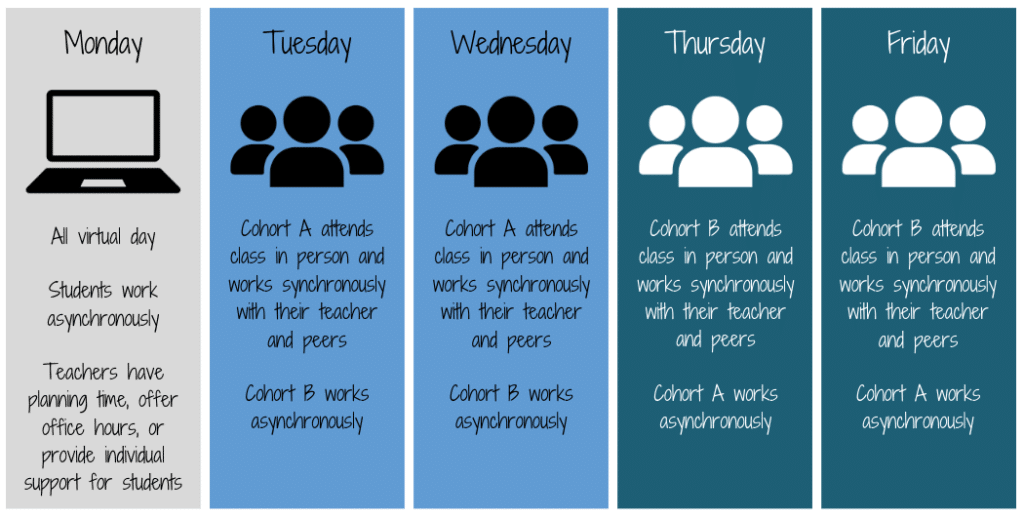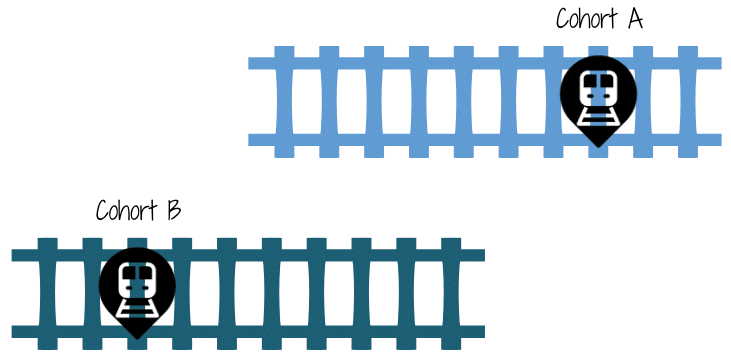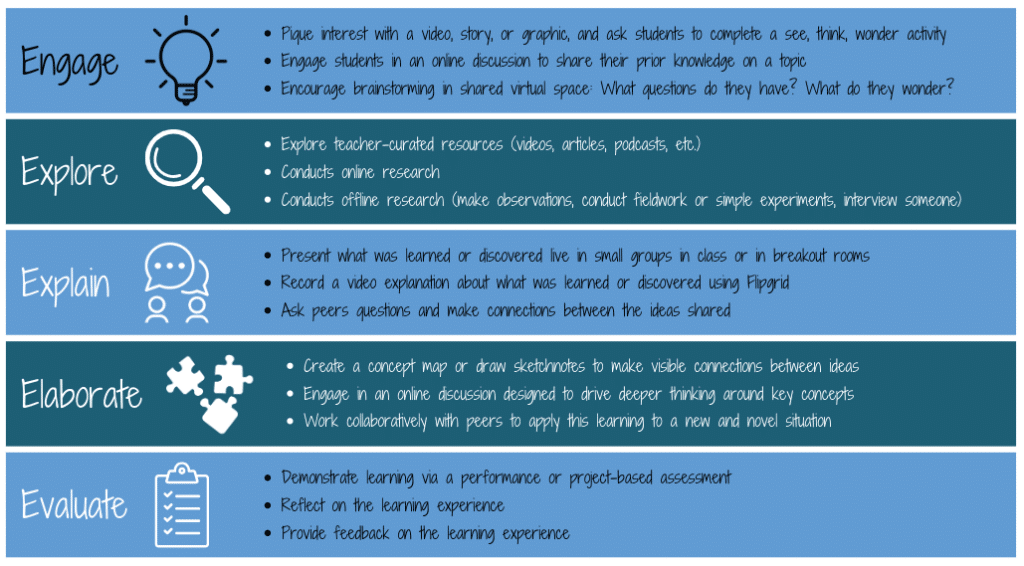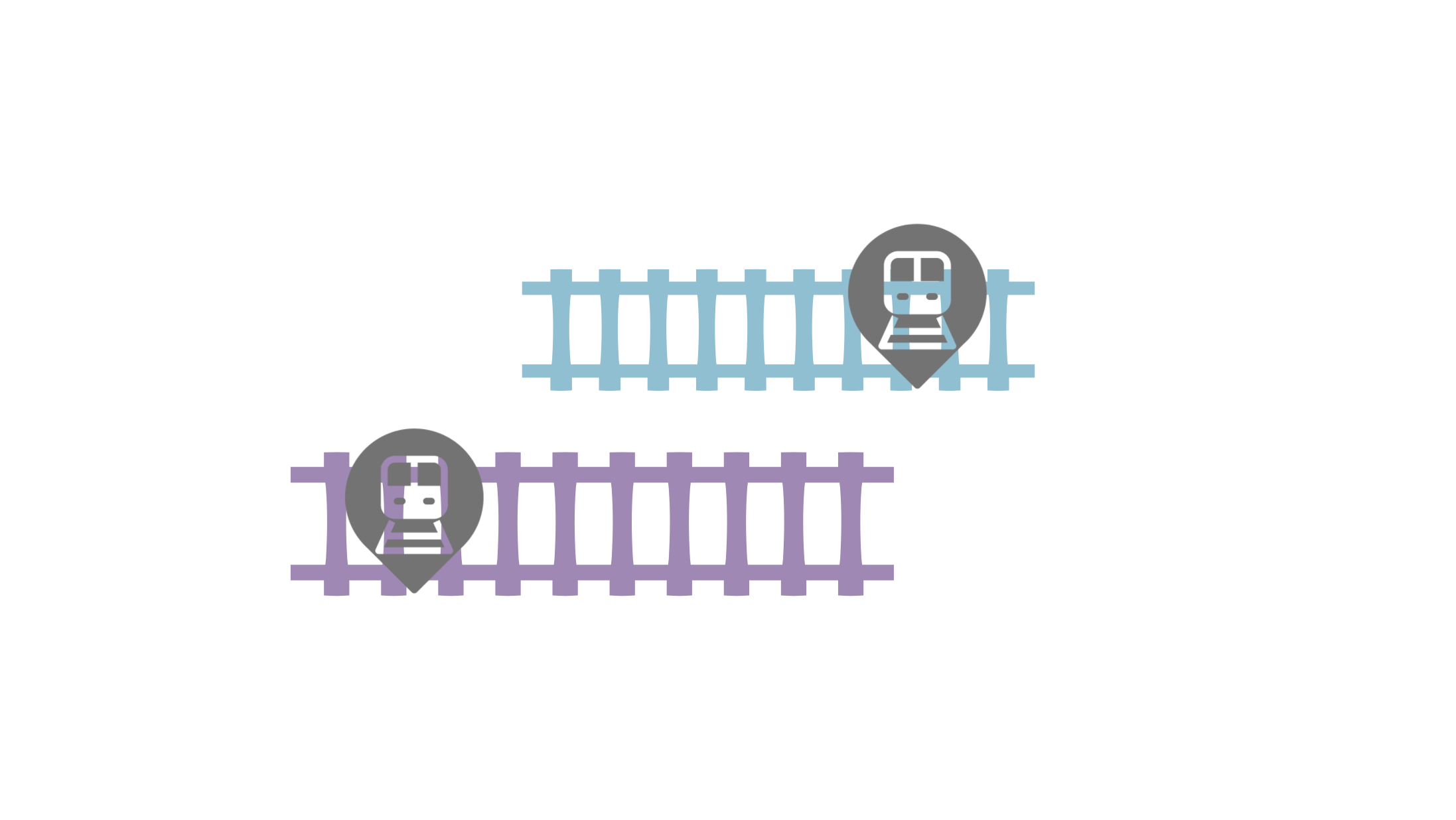As schools prepare to accommodate more in-person learning, many are opting for a hybrid schedule that divides the student body into two groups that will alternate days on campus to keep numbers lower in classrooms and allow for social distancing.

Typically, the hybrid schedule includes an all-virtual day–usually on a Monday or a Wednesday. The all-virtual day gives the teacher time to plan, host office hours, or work online with individual or small groups of students who need additional support. The rest of the week is divided between the two groups of students. On two consecutive days, one group of students (cohort A) attends school and learns synchronously in classrooms with the teacher and their peers. After they have had their two days of in-person learning, they shift online to work asynchronously, and the second group of students (cohort B) attends class in person.
Though this approach has presented challenges for teachers in terms of design, I believe this scenario is more manageable than the concurrent classroom, where teachers juggle a group in class and a group online simultaneously. However, to make this hybrid schedule work well, teachers must design and facilitate learning with a high level of intentionality.
- What learning activities will benefit students being in close physical proximity with the teacher and their peers?
- Which learning activities will benefit from students having more control over the time, place, and pace of their learning?
- How can we maximize our time together while also leveraging the affordances of self-paced learning to ensure the asynchronous work is interesting and engaging?
- How do we stagger the two groups’ progress through the curriculum to avoid creating an online and offline version of every lesson?
Stagger the Groups’ Progress to Avoid More Design Work
Let’s begin with an analogy. Imagine your two groups of students–cohort A and cohort B–are two trains running on parallel tracks. We cannot have the two trains side-by-side in terms of their progress, or the teacher will be scrambling to recreate the in-class experience for an online setting to keep the two cohorts progressing at the same rate. Instead, we need to think of one train out ahead of the other. Cohort A will be half a week ahead of cohort B in terms of the content and curriculum.

That means both groups will complete the same asynchronous work to prepare for class. They will also complete the same post-class work to process, review, or reflect on the in-class experience. Now, I use the word “same,” but within the asynchronous work, we will want to design for learner variability and build choice into those experiences, so they are not a one-size-fits-all experience.
Synchronous vs. Asynchronous: Design with Intention
As teachers plan for a hybrid schedule week, they will need to decide which learning activities will work best in class and which will work best online. In an earlier post, I shared some suggestions for thinking about synchronous vs. asynchronous learning. I recommend teachers pull any learning activity that will benefit from human interaction, peer support, and social learning into synchronous time. By contrast, teachers should reserve any learning activity that will benefit from the learner controlling the time, place, or pace of their learning for asynchronous time.
It may also help to think about what students can do to prepare for class to maximize this precious synchronous time together and what can reinforce the learning when students leave the classroom.

Use the 5Es Instructional Model to Design for the Asynchronous Time
Another strategy for maximizing the asynchronous time is to design a student-centered inquiry on a high-interest topic or essential question for students to self-pace through. The topic or question driving a 5Es inquiry cycle can be related to the work students are doing in class. For example, a social science teacher covering early American history could complement that work with a question like, “What did it mean to be an American?”
If anyone is looking for a fantastic resource on crafting an essential question, I recommend Jay McTighe’s work. ASCD posted the chapter from his book on essential questions titled “What Makes a Question Essential?” which has a collection of excellent examples. A great example of an essential question for history or social science is “Whose story is it?”
Once the teacher, or the students, have determined a topic of interest or crafted an essential question, the goal of the 5Es instructional model is to move students through the following stages: engage, explore, explain, elaborate, and evaluate.

A 5Es instructional model typically spans 2-3 weeks in length depending on the scope of the student-centered inquiry. So, teachers can put together an inquiry that can serve to engage students during their asynchronous work without having to create something new every week.
Need More Support?
I know navigating these new schedules and designing a combination of in-person and online learning can be daunting. For teachers and school districts that need additional support designing and facilitating learning in blended learning or online learning environments, I have created two self-paced courses–Getting Started with Blended and Online Learning and Advancing with Blended and Online Learning. The advanced course includes a deep dive into the 5Es instructional model and is on sale through the end of this week! The courses are composed of instructional videos, activities designed to encourage application and implementation, templates, and resources. You can self-pace through the courses focusing on the most relevant strategies to your work. District leaders can submit a request for information regarding a bulk purchase of either or both courses.


6 Responses
Is this for typical learners or for all learners ? I teach EC students and have been reflecting on the loss of learning our fully virtual day brings. Across the 36 weeks of school my students have lost approximately 7 weeks of instruction (nearly 1/4 of the school year by having Wednesday off. The change to Monday would lessen this effect but not fully eradicate it. Do you think there are some populations who would benefit from 5 days of in person instruction.
Hi Beth,
Although some schools are using this format for most students, many are making acceptions for special populations of learners who need more support. For example, I’ve heard of several districts that have pulled students with individualized education plans, special needs, or second language learners on campus multiple days a week or even every day because they need more support.
Yes, I definitely think there are populations of learners who will benefit from being on campus 5 days a week for in-person learning. I think the challenge is keeping students and staff safe, so some schools are trying to keep numbers low using this hybrid approach.
Catlin
I so wish your description is what my district has planned, but it is not. 4 days a week I am teaching but in class and online at the same time. Wednesdays all students are online and we are holding class that day, too. I hold office hours 5 days a week after school.
I really like this idea, because concurrent teaching is so hard in terms of student engagement. What do you suggest for the students who are fully remote? In each class I teach, I have at least 3 full remote kids–and sometimes, even students who are sign-up for in-person, don’t show (due to quarantining or weather or who knows why). Trying to think about how to balance all scenarios.
Thanks for supporting teachers during this time!
Hi Sara,
I’ve written several blogs on the concurrent classroom because it is such a challenging teaching scenario. They may be useful in providing some ideas for how to design for and facilitate learning in the concurrent classroom to keep your online students engaged. Below is a link to all the blogs I’ve written about the concurrent classroom.
https://catlintucker.com/?s=concurrent
Take care.
Catlin
Hi Catlin,
This is such a beneficial post. I first came across the 5Es on Hyperdocs.co. I think as you pointed out, 5Es can definitely help students to better demonstrate their learning.